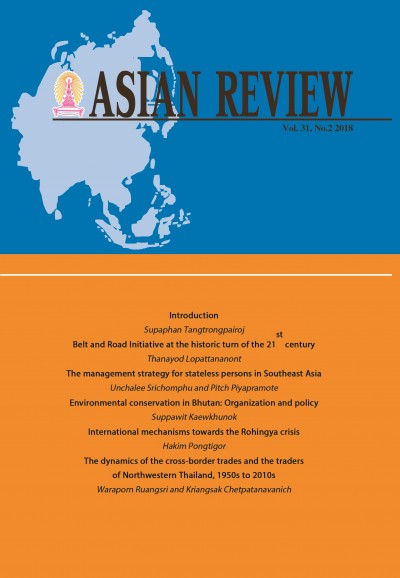The dynamics of the cross-border trades and the trades and the traders of Northwestern Thailand, 1950s to 2010s
Keywords:
The dynamics of the cross-border tradesAbstract
This research examines the dynamics of cross-border trade and the lives of the traders in the northwest part of Th ailand between the 1950s and 2010s, focusing on Mae Hong Son, a border province close to Burma. Since the 18th century, the ethnic Tai traders transported commodities by pack-saddle on trade routes cutting across northern Th ailand, Shan state, and the south of Burma. Under the process of nation-building throughout the 20th century and especially the centralization of the economy, their trading activities eventually came to a halt. Th e article explores three main points. First, it highlights the impact of the economic reform of border trades on the trader’s lived experiences through an exploration of the remaining traders’ collective memories.2 Second, memories of cross-border trade are interconnected with socio-cultural relations along the border between Th ailand and Myanmar, and the research argues that memories of cultural ties and the historical turning point mentioned above are crucial for any understanding of cross-border trade in the modern era. Finally, the period under study coincides with what is commonly called the modernization era, which is often associated with free trade policies. Th e article highlights how crossborder trading in northwestern Th ailand in this era became a bone of contention between local traders and new entrepreneurs. Local traders know well the natural routes with informal border stations while the new entrepreneurs have offi cial support from both government and non-government agencies. Th is article contributes to an understanding of cross-border trade in a transnational context by supplementing economic history with social history.
References
Clifford, James. 1997. Routes: Travel and Translation in the Late Twentieth Century. Harvard University Press.
Donnan, Hastings and Thomas M. Wilson. 1998. Border Identities: Nation and State at International Frontiers. Cambridge: Cambridge University Press.
Donnan, Hastings and Thomas M. Wilson. 2010. Borderlands: Ethnographic Approaches to Security, Power, and Identity. Lanham: University Press of America.
Geertz, Clifford. 1973. Th e Interpretation of Cultures. New York: Basic Books.
Gupta, A and J. Ferguson, eds. 1997. Culture, Power, Place: Exploration in Critical Anthropology. Durham and London: Duke University Press. Hannerz, Ulf. 1996. Transnational Connections: Culture, People, Places. London and New York: Routledge.
Horstmann, Alexander and Reed L.Wadley, eds. 2006. Centering the Margin, Agency and International Frontiers. Cambridge: Cambridge University Press.
Lash, Scott and John Urry. 1994. Economies of Signs and Space. London: TCS/ Sage.
Nushnaphang Choomdee. 2012. “บนเส้นทางการเปลี่ยนแปลงกับการมีอยู่ ของท้องถิ่น ปาย ปางมะผ้า และขุนยวม” [On the way of change with local resources: Pai, Pang Ma Pha, Khun Yuam communities]. In Heritage Culture in Pai, Pang Ma Pha, Khun Yuam, Mae Hong Son, edited by Rassamee Choosonhdesh. Mae Hong Son: Investigating and molding lasting cultural heritage in Pai, Phang Ma Pha, Khun Yuam, Mae Hong Son Project.
Pinkaew Laungaramsri. 2006. “Women, Nation, and the Ambivalence of Subversive Identification along the Thai-Burmese Border.” SOJOURN: Journal of Social Issues in Southeast Asia 21(1): 68-89.
Rosaldo, Renato.1989. Culture and Truth: The Remaking of Social Analysis. Boston: Beacon Press.
Saldivar, José David. 1997. Border Matters: Remapping American Cultural Studies. Berkeley: University of California Press.
Tannenbaum, Nicola. 1997. “Hill Field, Reforestation, and the Construction of Inequality in Maehongson Province, Thailand.” In Workshop in Political Theory and Policy Analysis. Bloomington: Indiana University.
Thas Srirattanabal. 2010. “ไทยใหญ่แม่ฮ่องสอน: การสร้างสรรค์ความเป็น ไทยใหญ่จากปฏิสัมพันธ์ระหว่างไทยใหญ่เดิมและไทยใหญ่พลัดถิ่น ทศวรรษ 2520-2550” [Tai Yai Mae Hong Son: creation of Tai Yai-ness through relations between old Tai Yai and refugee Tai Yai, 1977-2007]. MA dissertation, Faculty of Humanities, History Division, Chiang Mai University.
TNA (Thailand National Archives). 1889-91. “Chiang Mai report Rattanakosin era 107-109.” R.5 M2.12K.19/22.
TNA (Thailand National Archives). 1902-11. “Official Report of Pha Yup Circle 11 April Rattanakosin era 120-10 September Rattanakosin era 129.” R.5 M.60/44.
Tonkin, Elizabeth. 1992. Narrating our Pasts: the Social Construction of Oral History. Cambridge: Cambridge University Press.
Walker, Andrew. 1999. Th e Legend of the Golden Boat. Surrey: Curzon Press.
Waraporn Ruangsri. 2013. “Border Trade and the Transformation of State in the Hinterland of Peninsular Southeast Asia from the 19th Century to the Early 20th Century.” Ph.D.dissertation, Faculty of Arts, History Division, Chulalongkorn University.
Waterson, Roxana, ed. 2007. Southeast Asian Lives: Personal Narrative and Historical. Singapore: NUS Press.
Wichian Phulvanich. 2014. เส้นทางการทําไม้สัมปทานแม่สะเรียงในอดีต [Timber concession routes in the history of Mae Sariang]. Chiang Mai: The Project Research “Border and Diversity of Belief System.” Department of Sociology and Anthropology, Faculty of Social Sciences, Chiang Mai University.
Wichian Phulvanich. 2017. แม่สามแลบดินแดนลุ่มน้ําสาละวิน [Mae Samlaeb the land on basin of Salween River]. Chiang Mai: The Project Research “Border and Diversity of Belief System.” Department of Sociology and Anthropology, Faculty of Social Sciences, Chiang Mai University.
Yos Santasombat. 2008. อํานาจ, พื้นที่, และอัตลักษณ์ทางชาติพันธุ์: การเมือง วัฒนธรรมของรัฐชาติในสังคมไทย [Power, Space, and The Ethnic Identity: Culture-Politics of The nation State in Thai Society]. Bangkok: Princess Maha Chakri Sirindhorn Anthropology Center.
Interviews
January 23, 2015, a shopkeeper at Khun Yuam.
July 31, 2015, a Muslim Trader at Mae Sariang.
July 2, 2015, a local entrepreneur at Mae Sariang.
July 30 to August 2, 2015, a Bengali Trader at Khun Yuam.
July 30 to August 2, 2015, a Tor Pae Villager.
February 6, 2016, a Mae Sariang Informant.
February 8, 2016, a Tai Scholar and Director of the Tai Yai Center in Mae Hong Son.
Downloads
Published
How to Cite
Issue
Section
License
Published articles are under the copyright of the Instiute of Asian Studies, Chulalongkorn University. Partially or totally publication of an article elsewhere is possible only after the consent from the editors.







